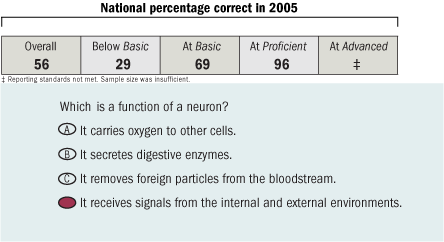2005 NAEP Science Sample Questions
The sample questions below give a brief introduction to the materials that were used to assess the science ability of students in grades 4, 8, and 12. All questions are based on the NAEP science framework, which defines the test design and content. The framework was developed through an extensive national consensus process and adopted by the National Assessment Governing Board (NAGB). Visit the NAGB website to download the full text of the 2005 science framework.
The science assessment consisted of both multiple-choice and constructed-response questions. Students answered questions classified in three major fields of science: Earth science, life science, and physical science. In addition, the NAEP science assessment included hands-on tasks. These performance tasks required students to conduct experiments using materials provided to them. Read more about the importance of performance tasks in the science framework. To understand what these experiments are like, see examples that were released from the 1996 science assessment:

Find out more about what the science assessment measures, and read the descriptions of each of the three major fields of science and three characteristic elements of knowing and doing science. Read more about how the assessment was developed, including information about the process used to score constructed-response questions.
Several other tools are available to help students, parents, and teachers look more closely at NAEP questions. View the item maps that provide concrete examples of what students at various achievement levels likely know and can do. Visit the NAEP Questions Tool to search over 1,800 items in all NAEP subject areas.
Sample Grade 4 Multiple-Choice Question
The following multiple-choice question from the fourth-grade science assessment required conceptual understanding in the field of Earth science.The percentages above the question indicate how students performed on the question. In addition to the overall percentage of students who answered the question correctly, the percentage of students at each achievement level who answered correctly is presented. For example, 46 percent of the students scoring at the Basic level answered this question correctly, and 90 percent of the students at the Advanced level answered correctly.

See more about this question in the NAEP Questions Tool.
View this question, at score 189, on a map of NAEP science items.
Back to Top
Sample Grade 4 Short Constructed-Response Question
The following is a constructed-response question requiring practical reasoning in the field of physical science. Responses were rated using a three-level scoring guide. Responses which stated that the water level goes up more in cup 1 and gave a correct explanation were rated “Complete.” Responses which stated that the water level goes up more in cup 1, but had an inadequate explanation, were rated “Partial.” Responses which stated that the water level goes up more in cup 2, or that ball 2 pushes the water level higher in cup 2, were rated as “Incorrect.” The sample student response shown here was “Complete.”

See more about this question in the NAEP Question Tool.
View this question, at score 159, on a map of NAEP science items.
Back to Top
Sample Grade 8 Multiple-Choice Question
The following multiple-choice question from the eighth-grade science assessment required conceptual understanding in the field of life science.

See more about this question in the NAEP Questions Tool.
View this question, at score 198, on a map of NAEP science items.
Back to Top
Sample Grade 8 Short Constructed-Response Question
The following constructed-response question was categorized as scientific investigation in physical science. Responses were rated using a three-level scoring guide. Responses that showed an understanding of how to distinguish fresh water from salt water by describing both a method for determining the difference and a result were rated “Complete.” Responses that showed some understanding of the difference between fresh and salt water but provided no practical method for distinguishing them, or gave a correct method but no result, were rated “Partial.” Responses that showed no understanding of how to distinguish between fresh and salt water were rated “Incorrect.” The sample student response below was “Complete.”

See more about this question in the NAEP Questions Tool.
View this question, at score 230, on a map of NAEP science items.
Back to Top
Sample Grade 12 Multiple-Choice Question
The following multiple-choice question from the twelfth-grade science assessment required conceptual understanding in the field of life science.

See more about this question in the NAEP Questions Tool.
View this question, at score 167, on a map of NAEP science items.
Back to Top
Sample Grade 12 Short Constructed-Response Question
The following is a constructed-response question requiring conceptual understanding in the field of Earth science. Responses were rated using a three-level scoring guide. Responses that correctly identified two conditions that cause rocks to undergo physical weathering and explained their action were rated “Complete.” Responses that correctly identified one condition and explained its action, or correctly identified one or more conditions with incorrect or no explanations were rated “Partial.” Responses that showed no understanding of what processes cause the deterioration of rocks were rated “Incorrect.” The sample student response below was “Complete.”

See more about this question in the NAEP Questions Tool.
View this question, at score 209, on a map of NAEP science items.
Back to Top